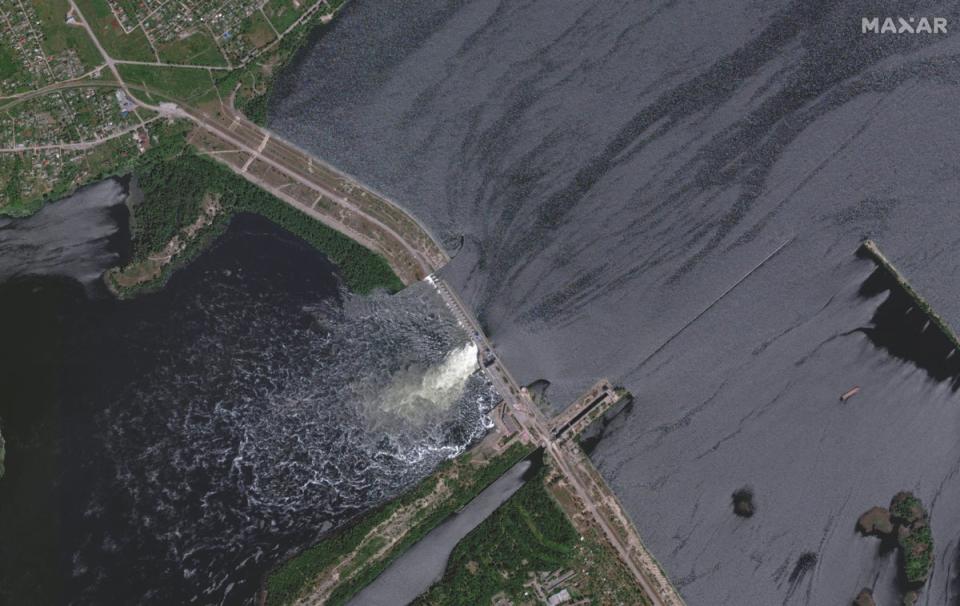OPINION - The apocalyptic images of Ukraine’s blown dam show Putin’s desperation

The summer campaign has opened in Ukraine. In a move of desperate vandalism, Russia appears to have ordered the blowing up of the Nova Kakhovka dam on the Dnipro, and widespread flooding could threaten the stability of the Zaporizhzhia nuclear complex. Even so, it is hard to see the fighting bringing a conclusion over the coming months.
For Ukraine’s forces surprise is now vital. That is why reports of the actions of the past two days must be treated with reservation. Russia has claimed a successful battle in open fields in Donetsk, destroying a squadron of tanks, numerous armoured carriers and 250 Ukrainian infantry dead.
As the commentator Phillips O’Brien put it last night, “much of the original reporting on where Ukraine is probing is exactly where the Russians might have expected them to attack — and where the Russians have strong positions. A Ukrainian colleague suggests these are just diversionary attacks.”
It will be days before the main objectives of the new campaign are revealed. Expect surprises. This is war is being fought in all five dimensions, ground, air, sea, cyber space, and space. It is the first digital war. A lot of the targeting information, surveillance, aspects of cyber and electronic deception operations are opaque, and not easily described in the crude terms demanded by the mainstream news business.
The defence ministry in Kyiv has said its forces have sufficient munitions and equipment for the opening of the campaign. But it will need a lot more, including modern strike aircraft like the F-16s, to reach a successful culmination by September, or October at the latest.
This will require a sustained effort by Nato and the EU, which is at last establishing a long-term strategy first to sustain Ukraine through the war, and for subsequent reconstruction.
This will be the prime talking point at the Nato summit in Vilnius next month. New force formations, with new equipment, doctrine and command, will have to be established to meet a continuous challenge from Moscow to reshape European security and politics on their terms over the next decade. “Since the Nineties, Russia has set out to change international borders by force nine times,” the former Nato Supreme Commander John Allen told the BBC yesterday, “and they don’t look like changing soon.”
The Vilnius summit will have to address Ukraine, Moldova and Georgia joining the Nato alliance. This can no longer be kicked into the long grass with a cloud of vague diplomatic-speak. Ukraine cannot be left like a European Israel, heavily armed but isolated, and potentially becoming maverick. Bound into the alliance, Ukraine and its forces would have to follow the alliance rules.
The Nato allies at Vilnius should recognise that the Ukraine conflict of the past 14 months marks a departure in the way of war itself — the war of the Information Age — to which they now need to adapt in very short order. It means the forward positioning of rapid-reaction formations that can respond to signals intelligence, the product of huge surveillance, in hours and days, not weeks and months. The shaping of a new Nato will top the agenda for the new secretary-general, due to be announced at the summit. The frontrunners are Ben Wallace, our Defence Secretary, and Mette Frederiksen, Denmark’s PM. Both have been prominent in leading the innovative 10-nation Joint Expeditionary Force group.
This makes the case for urgent reform and retooling of British defence policy and strategy, and the forces themselves. Future operations of scale will have to be run from a central information and command centre — a giant electronic brain close to the centre of political power in London. Today command of the forces is scattered across nearly a dozen headquarters across the country.
The Government has an opportunity in the new Defence Command policy paper due in the next few weeks.
But what of Russia and President Putin’s plans? It is far from clear what he wants and when and how he wants to stop the war. This now seems to worry Beijing and President Xi as much as the European capitals and President Biden.
This weekend the precious and fragile Trinity Icon, by the 15th- century master Andrei Rublev, was moved from its position in the Tretyakov Gallery to the Moscow cathedral on Mr Putin’s express orders. Meanwhile, he has said nothing about the renewed fighting in Ukraine — an omission of ominous significance, perhaps.

 Yahoo Sport
Yahoo Sport 





































